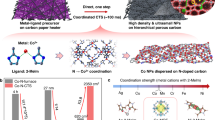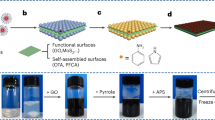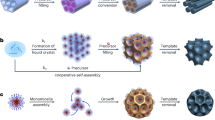Abstract
Even after a decade or so of research, the direct synthesis of highly crystalline mesoporous transition-metal oxides that are thermally stable and well ordered still constitutes a major challenge. Although various soft- and hard-templating approaches have been developed in the past, they usually suffer from multiple, tedious steps and often result in poor structure control. For many applications including power generation and energy conversion, however, high crystallinity and controlled mesoporosity are a prerequisite. To this end, here we report on an approach established for group-IV (titanium) and group-V (niobium) oxides, with potential applications to photovoltaic cells and fuel cells, respectively, which overcomes previous limitations. It gives direct access to the desired materials in a ‘one-pot’ synthesis using block copolymers with an sp2-hybridized carbon-containing hydrophobic block as structure-directing agents which converts to a sturdy, amorphous carbon material under appropriate heating conditions. This in situ carbon is sufficient to act as a rigid support keeping the pores of the oxides intact while crystallizing at temperatures as high as 1,000 ∘C.
This is a preview of subscription content, access via your institution
Access options
Subscribe to this journal
Receive 12 print issues and online access
$259.00 per year
only $21.58 per issue
Buy this article
- Purchase on Springer Link
- Instant access to full article PDF
Prices may be subject to local taxes which are calculated during checkout






Similar content being viewed by others
References
Ying, J. Y., Mehnert, C. P. & Wong, M. S. Synthesis and applications of supramolecular-templated mesoporous materials. Angew. Chem. Int. Edn 38, 56–77 (1999).
Schüth, F. & Schmidt, W. Microporous and mesoporous materials. Adv. Mater. 14, 629–638 (2002).
Kresge, C. T., Leonowicz, M. E., Roth, W. J., Vartuli, J. C. & Beck, J. S. Ordered mesoporous molecular sieves synthesized by a liquid-crystal template mechanism. Nature 359, 710–712 (1992).
Asefa, T., MacLachan, M. J., Coombs, N. & Ozin, G. A. Periodic mesoporous organosilicas with organic groups inside the channel walls. Nature 402, 867–871 (1999).
Garcia, C., Zhang, Y. M., DiSalvo, F. & Wiesner, U. Mesoporous aluminosilicate materials with superparamagnetic γ-Fe2O3 particles embedded in the walls. Angew. Chem. Int. Edn 42, 1526–1530 (2003).
Mokaya, R. Ultrastable mesoporous aluminosilicates by grafting routes. Angew. Chem. Int. Edn 38, 2930–2934 (1999).
Ohtani, B., Ogawa, Y. & Nishimoto, S. J. Photocatalytic activity of amorphous-anatase mixture of titanium(IV) oxide particles suspended in aqueous solutions. Phys. Chem. B 101, 3746–3752 (1997).
Antonelli, D. M. & Ying, Y. J. Synthesis of a stable hexagonally packed mesoporous niobium oxide molecular sieve through a novel ligand-assisted templating mechanism. Angew. Chem. Int. Edn 35, 426–430 (1996).
Ciesla, U., Schacht, S., Stucky, G. D., Unger, K. K. & Schüth, F. Formation of a porous zirconium oxo phosphate with a high surface area by a surfactant-assisted synthesis. Angew. Chem. Int. Edn 25, 541–543 (1996).
Shirokura, N. et al. Synthesis of crystallized mesoporous transition metal oxides by silicone treatment of the oxide precursor. Chem. Commun. 20, 2188–2190 (2006).
Yang, P., Zhao, D., Margolese, D. I., Chmelka, B. F. & Stucky, G. D. Generalized syntheses of large-pore mesoporous metal oxides with semicrystalline frameworks. Nature 396, 152–155 (1998).
Lee, B., Lu, D., Kondo, J. N. & Domen, K. Three-dimensionally ordered mesoporous niobium oxide. J. Am. Chem. Soc. 124, 11256–11257 (2002).
Wu, C.-W., Ohsuna, T., Kuwabara, M. & Kuroda, K. Formation of highly ordered mesoporous titania films consisting of crystalline nanopillars with inverse mesospace by structural transformation. J. Am. Chem. Soc. 128, 4544–4545 (2006).
Feng, J. & Bruce, P. G. Two and three dimensional mesoporous iron oxides with microporous walls. Angew. Chem. Int. Edn 43, 5958–5961 (2004).
He, X. & Antonelli, D. Recent advances in synthesis and applications of transition metal containing mesoporous molecular sieves. Angew. Chem. Int. Edn 41, 214–229 (2002).
Antonelli, D. M. & Ying, J. Y. Synthesis of hexagonally packed mesoporous TiO2 by a modified sol–gel method. Angew. Chem. Int. Edn 34, 2014–2017 (1995).
Yang, P., Zhao, D., Margolese, D. I., Chmelka, B. F. & Stucky, G. D. Block copolymer templating syntheses of mesoporous metal oxides with large ordering lengths and semicrystalline framework. Chem. Mater. 11, 2813–2826 (1999).
Jiao, F. et al. Ordered mesoporous Fe2O3 with crystalline walls. J. Am. Chem. Soc. 128, 5468–5474 (2006).
Jiao, F. et al. Synthesis of ordered mesoporous Fe3O4 and γ-Fe2O3 with crystalline walls using post-template reduction/oxidation. J. Am. Chem. Soc. 128, 12905–12909 (2006).
Xiaoyong, L. et al. Ordered mesoporous copper oxide with crystalline walls. Angew. Chem. Int. Edn 46, 738–741 (2007).
Roggenbuck, J. & Tiemann, M. Ordered mesoporous magnesium oxide with high thermal stability synthesized by exotemplating using CMK-3 carbon. J. Am. Chem. Soc. 127, 1096–1097 (2005).
Li, W.-C., Lu, A.-H., Weidenthaler, C. & Schüth, F. Hard-templating pathway to create mesoporous magnesium oxide. Chem. Mater. 16, 5676–5681 (2004).
Lee, J., Kim, J. & Hyeon, T. Recent progress in the synthesis of porous carbon materials. Adv. Mater. 18, 2073–2094 (2006).
Ryoo, R., Joo, S. H. & Jun, S. Synthesis of highly ordered carbon molecular sieves via template-mediated structural transformation. J. Phys. Chem. B 103, 7743–7746 (1999).
Lee, J., Yoon, S., Hyeon, T., Oh, S. M. & Kim, K. B. Synthesis of a new mesoporous carbon and its application to electrochemical double-layer capacitors. Chem. Commun. 21, 2177–2178 (1999).
Zukalova, M. et al. Organized mesoporous TiO2 films exhibiting greatly enhanced performance in dye-sensitized solar cells. Nano Lett. 5, 1789–1792 (2005).
Drew, K., Girishkumar, G., Vinodgopal, K. & Kamat, P. Boosting fuel cell performance with a semiconductor photocatalyst: TiO2/Pt–Ru hybrid catalyst for methanol oxidation. J. Phys. Chem. B 109, 11851–11857 (2005).
Templin, M. et al. Organically modified aluminosilicate mesostructures from block copolymer phases. Science 278, 1795–1798 (1997).
Warren, S. C., DiSalvo, F. J. & Wiesner, U. Nanoparticle-tuned assembly and disassembly of mesostructured silica hybrids. Nature Mater. 6, 156–161 (2007).
Katou, T. et al. Crystallization of an ordered mesoporous Nb–Ta oxide. Angew. Chem. Int. Edn 42, 2382–2385 (2003).
Brezesinski, T., Erpen, C., Iimura, K. & Smarsly, B. Mesostructured crystalline ceria with a bimodal pore system using block copolymers and ionic liquids as rational templates. Chem. Mater. 17, 1683–1690 (2005).
Ba, J., Polleux, J., Antonietti, M. & Niederberger, M. Non-aqueous synthesis of tin oxide nanocrystals and their assembly into ordered porous mesostructures. Adv. Mater. 17, 2509–2512 (2005).
Acosta, S., Corriu, R., Leclercq, D., Mutin, P. H. & Vioux, A. Novel non-hydrolytic sol–gel route to metal oxides. J. Sol–Gel Sci. Technol. 2, 25–28 (1994).
Tanev, P. T. & Pinnavaia, T. J. A neutral templating route to mesoporous molecular sieves. Science 267, 865–867 (1995).
Lee, J., Yoon, S., Oh, S. M., Shin, C.-H. & Hyeon, T. Development of a new mesoporous carbon using an HMS aluminosilicate template. Adv. Mater. 12, 359–362 (2000).
Krawitz, A. D. Introduction to Diffraction in Materials Science and Engineering 168 (Wiley, New York, 2001).
Finnefrock, A. C., Ulrich, R., Toombes, G. E. S., Gruner, S. M. & Wiesner, U. The plumber’s nightmare: a new morphology in block copolymer-ceramic nanocomposites and mesoporous aluminosilicates. J. Am. Chem. Soc. 125, 13084–13093 (2003).
de Boer, J. H. The Structure and Properties of Porous Materials (Butterworths, London, 1958).
IUPAC, Reporting physisorption data for gas/solid systems. Pure Appl. Chem. 87, 603 (1957).
Barrett, E. P., Joyner, L. G. & Halenda, P. P. The determination of pore volume and area distributions in porous substances. I. Computations from nitrogen isotherms. J. Am. Chem. Soc. 73, 373–380 (1951).
Liang, C., Hong, K., Guiochon, G. A., Mays, J. W. & Dai, S. Nanoporous films: Synthesis of a large-scale highly ordered porous carbon film by self-assembly of block copolymers. Angew. Chem. Int. Edn 43, 5785–5789 (2004).
Kumar, C. P., Gopal, N. O., Wang, T. C., Wong, M.-S. & Ke, S. C. EPR investigation of TiO2 nanoparticles with temperature-dependent properties. J. Phys. Chem. B 110, 5223–5229 (2006).
Tian, B. et al. Self-adjusted synthesis of ordered stable mesoporous minerals by acid-base pairs. Nature Mater. 2, 159–163 (2003).
Hsieh, H. L. & Quirk, R. P. Anionic Polymerization: Principles and Practical Applications (Marcel Dekker, New York, 1996).
Allgaier, J., Poppe, A., Willner, L. & Richter, D. Synthesis and characterization of poly[1,4-isoprene-b-(ethylene oxide)] and poly[ethylene-co-propylene-b-(ethylene oxide)] block copolymers. Macromolecules 30, 1582–1586 (1997).
Acknowledgements
This work was supported by grants from the Department of Energy (DE-FG02 87ER45298) and the National Science Foundation (DMR-0605856). The work was further supported by the Korea Research Foundation Grant funded by the Korean Government (MOEHRD) (KRF-2005-214-D00298). Cornell High Energy Synchrotron Source (CHESS) is a national user facility supported by the National Science Foundation and the National Institute of General Medical Sciences. We thank A. Burns for help with the graphics and figures.
Author information
Authors and Affiliations
Corresponding author
Ethics declarations
Competing interests
We are in the process of generating a patent application based on the content of this paper.
Supplementary information
Supplementary Information
Supplementary tables S1-S2 and Supplementary figures S1-S10 (PDF 755 kb)
Rights and permissions
About this article
Cite this article
Lee, J., Christopher Orilall, M., Warren, S. et al. Direct access to thermally stable and highly crystalline mesoporous transition-metal oxides with uniform pores. Nature Mater 7, 222–228 (2008). https://doi.org/10.1038/nmat2111
Received:
Accepted:
Published:
Issue Date:
DOI: https://doi.org/10.1038/nmat2111
This article is cited by
-
Solvent-pair surfactants enabled assembly of clusters and copolymers towards programmed mesoporous metal oxides
Nature Communications (2023)
-
Bio-inspired synthesis of transition-metal oxide hybrid ultrathin nanosheets for enhancing the cycling stability in lithium-ion batteries
Nano Research (2022)
-
Mesoporous V2O5/g-C3N4 Nanocomposites for Promoted Mercury (II) Ions Reduction Under Visible Light
Journal of Inorganic and Organometallic Polymers and Materials (2021)
-
Annealing temperature-driven near-surface crystallization with improved luminescence in self‐patterned alumina films
Journal of Materials Science: Materials in Electronics (2021)
-
Recent advances in the synthesis of mesoporous materials and their application to lithium-ion batteries and hybrid supercapacitors
Korean Journal of Chemical Engineering (2021)



